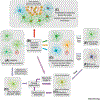Astrocyte Reactivity: Subtypes, States, and Functions in CNS Innate Immunity
- PMID: 32819810
- PMCID: PMC7484257
- DOI: 10.1016/j.it.2020.07.004
Astrocyte Reactivity: Subtypes, States, and Functions in CNS Innate Immunity
Abstract
Astrocytes are neural parenchymal cells that ubiquitously tile the central nervous system (CNS). In addition to playing essential roles in healthy tissue, astrocytes exhibit an evolutionarily ancient response to all CNS insults, referred to as astrocyte reactivity. Long regarded as passive and homogeneous, astrocyte reactivity is being revealed as a heterogeneous and functionally powerful component of mammalian CNS innate immunity. Nevertheless, concepts about what astrocyte reactivity comprises and what it does are incomplete and sometimes controversial. This review discusses the goal of differentiating reactive astrocyte subtypes and states based on composite pictures of molecular expression, cell morphology, cellular interactions, proliferative state, normal functions, and disease-induced dysfunctions. A working model and conceptual framework is presented for characterizing the diversity of astrocyte reactivity.
Copyright © 2020 The Author. Published by Elsevier Ltd.. All rights reserved.
Figures



References
-
- Magistretti PJ and Allaman I (2018) Lactate in the brain: from metabolic end-product to signalling molecule. Nat Rev Neurosci 19 (4), 235–249. - PubMed

